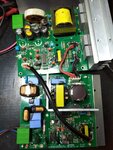elefant
Newbie level 5
Good day!
I have SMPS made in Korea, KSB Seil model SMPSS10A. I couldn't find any circuit diagram for that power supply. I'm not well experienced in solving electronic problems so i need some help.
After switching on it has 0 V output. After few minutes it starts to increase slowly and finally reaches its rated output 24 Volts. It doesn't matter whether load connected or idle. Only if it has reached 24 V and I switched off the power and immideately switched it on then ouput voltage become 24 VDC instantly. If i give this SMPS some "cooling" period without mains and then switch it again, so then it start to increase outut as it was described above.
I checked primary circuit, it gives stable 390 VDC after rectifier. This voltage is coming to power transistors input. But output from these transistors is zero and starts to increase only after few minutes.
So please give me some advice what elements i should check first. Or maybe somebody could help me to find circuit diagram for this power supply.
I have SMPS made in Korea, KSB Seil model SMPSS10A. I couldn't find any circuit diagram for that power supply. I'm not well experienced in solving electronic problems so i need some help.
After switching on it has 0 V output. After few minutes it starts to increase slowly and finally reaches its rated output 24 Volts. It doesn't matter whether load connected or idle. Only if it has reached 24 V and I switched off the power and immideately switched it on then ouput voltage become 24 VDC instantly. If i give this SMPS some "cooling" period without mains and then switch it again, so then it start to increase outut as it was described above.
I checked primary circuit, it gives stable 390 VDC after rectifier. This voltage is coming to power transistors input. But output from these transistors is zero and starts to increase only after few minutes.
So please give me some advice what elements i should check first. Or maybe somebody could help me to find circuit diagram for this power supply.
